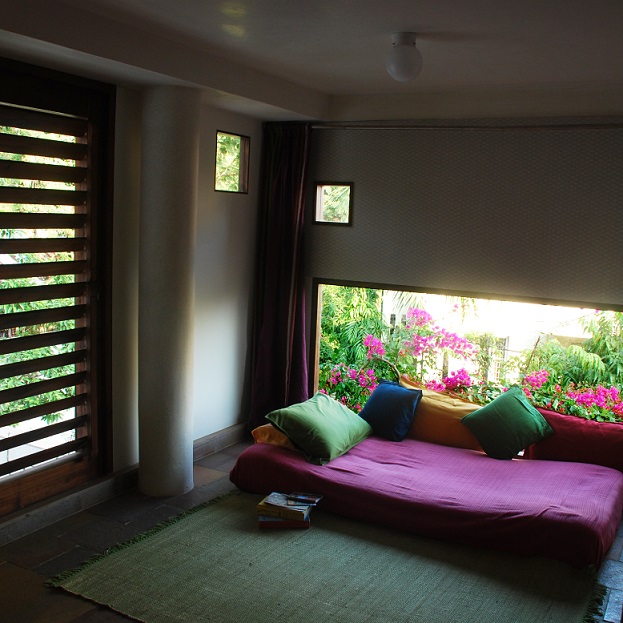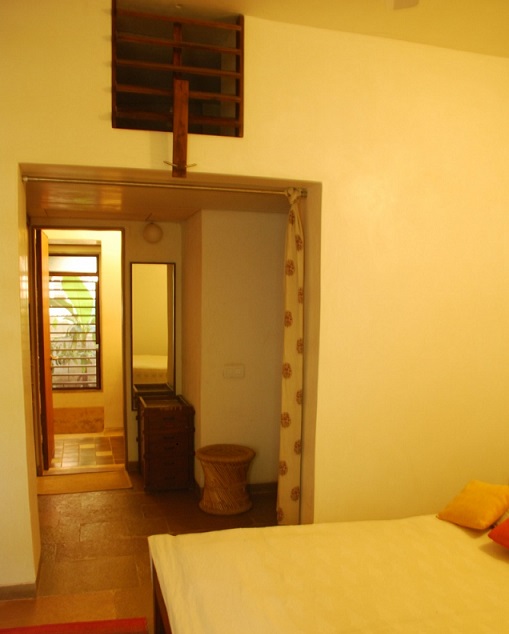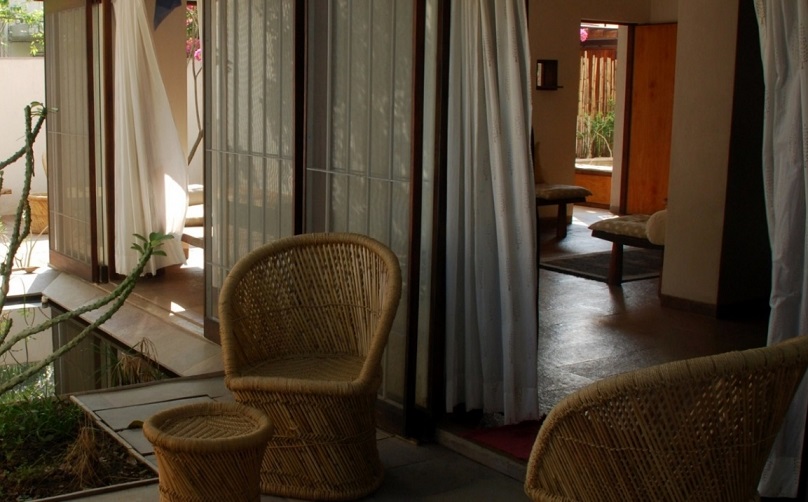Couple Turn Old Home ‘Green’, Beat Ahmedabad’s 42-Degree Summers Without an AC
Based in Ahmedabad, the couple have a rooftop rainwater harvesting system, a solar water heater and a vegetable garden!

Building a home that is comfortable to live in while also factoring in the environment can be tricky. Every component one uses to build their homes, has a hidden cost that nature has to bear.
But what do you do when you move into a home that has already been constructed? Is it too late to employ sustainable practices then?
Ahmedabad based couple Surya and Jaai Kakani break this myth. After moving into a conventionally constructed home, they decided to explore several possible alternative practices one could employ to afford comfort, both physical and aesthetic, without consuming excessively.

The duo has incorporated changes in the pre-existing structure that makes the home truly sustainable. Some of these include the natural air ventilation techniques and the application of cooling building materials that keep the interiors comfortable. So much so, that even in the sweltering 42 degrees celsius summer, the couple lives in their home without an air conditioner.
Additionally, the duo has a rainwater harvesting system through which they store about 16,000 litres of water in an underground water tank. They also recycle greywater, thereby helping in the conservation of a valuable resource. The vegetable garden on their terrace and strategically planted creepers provide further cooling to the structure.
From 2000 to 2009 the couple continued to live in the previously constructed home while getting clearer about the various emerging concerns over issues of sustainability and social practices. The significant changes around the house were started in 2009 and completed in the next year.

“Once we started living in the house, we knew that there were many qualities that were worth taking forward. We were convinced that we could work around the existing structure and still reduce the use of resources. In the Indian context, reducing heat and controlling light are concerns that immediately come to everyone’s mind. Other urgent concerns that we were looking at revolved around the way we use resources like water and energy; how we dispose of our waste; the high quantum of energy used in the production of newer building materials, known as embodied energy; and the skilled crafts that are getting obliterated,” says Surya.
In conversation with The Better India (TBI) the couple shares how by making particular shifts in design thinking and practice, a conventional home typology was not only converted into one that was sensitive to the dialogue of sustainability, but also one that met contemporary lifestyle needs.
Becoming more aware and conscious
Surya and Jaai coalesced their knowledge of architecture and design to reimagine and lead a sustainable life. Surya runs his own architectural firm while also working as a visiting faculty and critic, most notably at the faculty of architecture at CEPT in Ahmedabad, where he served as the dean from 2017 to 2020.

Jaai is a graphic designer and a visiting faculty at design institutes like the National Institute of Design (NID) and National Institute of Fashion Technology (NIFT). She is also the founder of Soach, an NGO based in Ahmedabad that works towards rural development, women’s empowerment (through skill training), and children’s education.
They moved into their current home (built in the 1970s by the Gujarat Housing Board) in the year 2000. They lived there for 10 years until they decided it was time to renovate the house and bring about changes that made the home sustainable.
“Most traditional building practices are by nature sustainable, but the skills and knowledge of these have been abandoned in our recent past, making way for a new notion of fast-paced urbanity. Yet, it is not so simple to say that one can pick up the old practices and plant them in today’s urban context. Rather, it requires understanding the science embedded in these systems and marrying them to newer emerging sustainable technologies and practices; thus making them relevant in today’s urban context”, says Surya.

Jaai adds, “To reduce our energy (resource) consumption, we did away with the AC. We learned that it is possible to do without it by making some design changes in the house. And, all of this we wanted to achieve without creating more waste. So, the first thing was to not trash the existing house.”
Naturally Cool home with efficient water use
To be able to achieve their goal of sustainability, modifications to the existing structure had to be made to keep the interiors cooler. They set about achieving this in many ways.
On the south face, there was no space for openings because of the adjoining house of their neighbour’s. So, a shaft was created that went beyond the roof, opening upwards into the sky allowing a downward draft of fresh air into all rooms. A ceiling fan and a wind-catcher at the very top of this shaft aid this process by pushing cool air down this 4-foot by 4-foot duct, the use of which is modulated as per changing seasons.

In summer days, the air is allowed in during the late evenings and until late mornings when the outside air temperatures fall. This air is released into five rooms across two floors, thus keeping the interiors comfortable even in peak summers. During the day-time, the duct remains shut and the thick lime plaster walls radiate the coolness absorbed of the night cycle breeze. In the humid season, the ducts remain open for maintaining comfort.
The west face of the house which gets the maximum duration of sun has smaller window openings and a layer of fixed wooden louvers, with creepers trailing on the louvers; minimizing heat gain from the west. The east face openings have flexible wooden louvers (made using upcycled wood) that can control the amount of sunlight into the rooms – morning to evening, summer to winter. The north which faces large trees has large clear windows that look out into the green of the IIM Ahmedabad compound.
Surya adds, “The top of every house gets the maximum duration and quantity of sun; one of the prime reasons in a building and its interiors heating up.”

The terrace is in two levels, the upper level designed for rainwater harvesting. The floor of the upper-level terrace is insulated by a thick layer of lightweight thermocol (of packaging waste) and lime concrete finished in smooth lime plaster.
The lower-level terrace has a vegetable garden, thus ensuring that the bedroom below it has a thicker cooler roof with the obvious additional delight of having fresh homegrown vegetables and another green outdoor for the room adjacent to it.
“On the lower half of the terrace, we started our terrace garden in 2010 with 10 inches of soil and have been able to grow vegetables like brinjals, okara, peas, carrots, beetroots along with different kinds of herbs. All of this we grow without any chemicals or pesticides. The monkeys in the area have been eyeing our garden for quite some time now,” laughs Jaai.
All these measures along with the interiors and exteriors of the walls plastered using lime together have helped the Kakani’s keep their abode a cool haven.

Furthermore, the water collected in the upper-level of the terrace is captured on the is connected to a 16,000 litre tank in the ground.
“For about 10 years now, we haven’t used municipal water for drinking or cooking purposes. This is the water that we use as it is connected to our kitchen,” informs Surya.
The excess water is diverted to ground recharge wells situated in the courtyard of the home keeping the flora and fauna happy. Other than that, the water from washing machines is recycled for flushing in toilets, and water from the kitchen is used to irrigate the banana plant in the kitchen court.
The duo also did away with geysers and have replaced it with a solar water heater instead.
Bringing the outside, inside
One of the best features of the house is that it seamlessly fits with nature and the surroundings. To experience a sense of openness, all common spaces such as the living room, dining room, and kitchen, flow into one another. This is achieved as there are no closed doors connecting them.

Boundaries are further dissolved between the inside and the outside by opening up all the windows, allowing a meander of spaces in and out. The ground plan works like a verandah with the plot boundaries having a court like sense, making it the perfect space to relax and unwind.
There were two small ponds constructed during the renovation — one at the entrance while the other in the courtyard. “These ponds have fish and lilies and since these water bodies hug the wall, it also helps in keeping the area cool. It’s so nice to see the monkeys, the neighbourhood cats and birds using this as a water hole, which makes us happy seeing they too are getting to enjoy the benefits,” Jaai says with a smile.
The outdoor space, though not large, has indigenous plants that have been carefully chosen for their fragrance and herbal delights. Most come from childhood memories rather than gardening books. The west wall of the house is also covered in cascading creepers that keep the house cool. And, Jaai informs that it’s a sensorial delight when the flowers in these creepers bloom, a sight to behold, and the fragrance refreshing.

“We were both passionate about living in this manner, and it was a huge learning process. But the benefits have been remarkable — in fact, the minute you make these small changes, you become one with the environment. And in current times, I feel it is important to tune in with nature in the larger context and make that extra effort,” states Jaai.
“I feel our bodies are capable of withstanding more than we make it out to be. The journey and experience of having made these changes, now, I cannot think of any other way. Finding alternatives is indeed possible. You just have to reimagine and reevaluate the way we consume and live,” says Surya signing off.
(Edited by Gayatri Mishra)
Like this story? Or have something to share?
Write to us: [email protected]
Connect with us on Facebook and Twitter.
If you found our stories insightful, informative, or even just enjoyable, we invite you to consider making a voluntary payment to support the work we do at The Better India. Your contribution helps us continue producing quality content that educates, inspires, and drives positive change.
Choose one of the payment options below for your contribution-
By paying for the stories you value, you directly contribute to sustaining our efforts focused on making a difference in the world. Together, let’s ensure that impactful stories continue to be told and shared, enriching lives and communities alike.
Thank you for your support. Here are some frequently asked questions you might find helpful to know why you are contributing?


This story made me
-
97
-
121
-
89
-
167











